A Design and Implementation of High-Efficiency Asymmetric Doherty Radio Frequency Power Amplifier for 5G Base Station Applications
Abstract
:1. Introduction
2. Fundamentals of the Doherty Architecture
2.1. Analyses of the Symmetric Doherty PA
2.2. The Principles of the Asymmetric Doherty PA
3. The Asymmetric PA Design and Simulations
3.1. The Bias Circuit, Matching Network, and Power Divider
3.2. Offset Line Techniques
3.3. Main Parameters and Simulations
4. The Improved Layout and Test
4.1. The Layout Designs
4.1.1. Redundant U-Shaped Microstrip Line Tuning Technique
4.1.2. The Multi-Stage Debugging Strategy
4.1.3. Circuit Implementation Based on U-Shaped Microstrip Lines and Independent Multi-Stage Debugging Strategy
4.2. Tests
4.2.1. Efficiency Test
4.2.2. Linearity Test
5. Conclusions
Author Contributions
Funding
Data Availability Statement
Conflicts of Interest
References
- Özen, M.; Andersson, K.; Fager, C. Symmetrical Doherty Power Amplifier with Extended Efficiency Range. IEEE Trans. Microw. Theory Tech. 2016, 64, 1273–1284. [Google Scholar] [CrossRef]
- Jia, P.; You, F.; He, S. A 1.8–3.4-GHz Bandwidth-Improved Reconfigurable Mode Doherty Power Amplifier Utilizing Switches. IEEE Microw. Wirel. Compon. Lett. 2020, 30, 102–105. [Google Scholar] [CrossRef]
- Ruhul Hasin, M.; Kitchen, J. Exploiting Phase for Extended Efficiency Range in Symmetrical Doherty Power Amplifiers. IEEE Trans. Microw. Theory Tech. 2019, 67, 3455–3463. [Google Scholar] [CrossRef]
- Hallberg, W.; Özen, M.; Gustafsson, D.; Buisman, K.; Fager, C. A Doherty Power Amplifier Design Method for Improved Efficiency and Linearity. IEEE Trans. Microw. Theory Tech. 2016, 64, 4491–4504. [Google Scholar] [CrossRef]
- Honda, S.; Sakata, S.; Komatsuzaki, Y.; Shinjo, S. Efficiency Enhancement of GaN Doherty Power Amplifier at Large Power Back-Off with Virtual Short Stub Technique. In Proceedings of the 2019 IEEE Asia-Pacific Microwave Conference (APMC), Singapore, 10–13 December 2019; pp. 294–296. [Google Scholar] [CrossRef]
- Liang, C.; Roblin, P.; Hahn, Y.; Xiao, Y. Automatic Algorithm for the Direct Design of Asymmetric Doherty Power Amplifiers. In Proceedings of the 2019 IEEE Topical Conference on RF/Microwave Power Amplifiers for Radio and Wireless Applications (PAWR), Orlando, FL, USA, 20–23 January 2019; pp. 1–4. [Google Scholar] [CrossRef]
- Mengozzi, M.; Gibiino, G.P.; Angelotti, A.M.; Santarelli, A.; Florian, C.; Colantonio, P. Automatic Optimization of Input Split and Bias Voltage in Digitally Controlled Dual-Input Doherty RF PAs. Energies 2022, 15, 4892. [Google Scholar] [CrossRef]
- Grams, V.; Seidel, A.; Stärke, P.; Wagner, J.; Ellinger, F. Analysis and Design of an Asymmetric Doherty Power Amplifier at 2.6 GHz using GaAs pHEMTs. In Proceedings of the 2019 IEEE International Conference on Microwaves, Antennas, Communications and Electronic Systems (COMCAS), Tel-Aviv, Israel, 4–6 November 2019; pp. 1–3. [Google Scholar] [CrossRef]
- Asbeck, P.; Popovic, Z. ET Comes of Age: Envelope Tracking for Higher-Efficiency Power Amplifiers. IEEE Microw. Mag. 2016, 17, 16–25. [Google Scholar] [CrossRef]
- Masood, M.; Srinidhi, E.R.; Rashev, P.; Holt, J.; Kenney, J.S. 300 W Dual Path GaN Doherty Power Amplifier with 65% Efficiency for Cellular Infrastructure Applications. In Proceedings of the 2020 IEEE/MTT-S International Microwave Symposium (IMS), Los Angeles, CA, USA, 4–6 August 2020; pp. 715–718. [Google Scholar] [CrossRef]
- Fang, X.H.; Liu, H.Y.; Cheng, K.K.M. Extended Efficiency Range, Equal-Cell Doherty Amplifier Design Using Explicit Circuit Model. IEEE Microw. Wirel. Compon. Lett. 2017, 27, 497–499. [Google Scholar] [CrossRef]
- R, S.E.; McLaren, R.; Masood, M. High Power 400 W Symmetric Doherty with Extended Back-off Efficiency Range for 5G Cellular Infrastructure Applications. In Proceedings of the 2020 50th European Microwave Conference (EuMC), Utrecht, The Netherlands, 12–14 January 2021; pp. 300–303. [Google Scholar] [CrossRef]
- Saad, P.; Hou, R.; Hellberg, R.; Berglund, B. A 1.8–3.8-GHz Power Amplifier with 40% Efficiency at 8-dB Power Back-Off. IEEE Trans. Microw. Theory Tech. 2018, 66, 4870–4882. [Google Scholar] [CrossRef]
- Shen, C.; He, S.; Zhu, X.; Peng, J.; Cao, T. A 3.3–4.3-GHz High-Efficiency Broadband Doherty Power Amplifier. IEEE Microw. Wirel. Compon. Lett. 2020, 30, 1081–1084. [Google Scholar] [CrossRef]
- Bhardwaj, S.; Kitchen, J. Broadband Parallel Doherty Power Amplifier in GaN for 5G Applications. In Proceedings of the 2019 IEEE Topical Conference on RF/Microwave Power Amplifiers for Radio and Wireless Applications (PAWR), Orlando, FL, USA, 20–23 January 2019; pp. 1–3. [Google Scholar] [CrossRef]
- Qi, L.; Yin, H.; Chen, P.; Cai, J.; Zhu, X.W.; Yu, C.; Hong, W. Multi-Section Support Vector Regression-Based Behavioral Modeling of RF GaN Doherty Power Amplifiers. In Proceedings of the 2021 IEEE MTT-S International Wireless Symposium (IWS), Nanjing, China, 23–26 May 2021; pp. 1–3. [Google Scholar] [CrossRef]
- Pednekar, P.H.; Hallberg, W.; Fager, C.; Barton, T.W. Analysis and Design of a Doherty-like RF-Input Load Modulated Balanced Amplifier. IEEE Trans. Microw. Theory Tech. 2018, 66, 5322–5335. [Google Scholar] [CrossRef]
- Wong, J.; Watanabe, N.; Grebennikov, A. High-power high-efficiency broadband GaN HEMT Doherty amplifiers for base station applications. In Proceedings of the 2018 IEEE Topical Conference on RF/Microwave Power Amplifiers for Radio and Wireless Applications (PAWR), Anaheim, CA, USA, 14–17 January 2018; pp. 16–19. [Google Scholar] [CrossRef]
- Yadav, P. Optimizing the Doherty Amplifier: Design of a 3-GHz GaN Doherty Amplifier Achieving 60% Efficiency. IEEE Microw. Mag. 2020, 21, 88–95. [Google Scholar] [CrossRef]
- Horiguchi, K.; Ishizaka, S.; Nakayama, M.; Hayashi, R.; Isota, Y.; Takagi, T. Efficiency enhancement of a digital predistortion Doherty amplifier transmitter using a virtual open stub technique. IEICE Trans. Electron. 2007, E90C, 1670–1677. [Google Scholar] [CrossRef]
- Iizuka, F.; Ogino, T.; Suzuki, H.; Fukawa, K. High-efficiency Doherty linear amplifier with backoff control for mobile communications. In Proceedings of the 2005 IEEE 61st Vehicular Technology Conference, Stockholm, Sweden, 30 May–1 June 2005; Volume 2, pp. 949–953. [Google Scholar] [CrossRef]
- Lopera, J.R.; Mayock, J.; Sun, Q.; Gadringer, M.; Bösch, W.; Leitgeb, E. A 3.5 GHz High Power GaN Hybrid Doherty Power Amplifier with Dynamic Input Power Splitting for Enhanced Power Added Efficiency at Backoff. In Proceedings of the 2021 IEEE Topical Conference on RF/Microwave Power Amplifiers for Radio and Wireless Applications (PAWR), San Diego, CA, USA, 17–20 January 2021; pp. 1–4. [Google Scholar] [CrossRef]
- Fager, C.; Hallberg, W.; Özen, M.; Andersson, K.; Buisman, K.; Gustafsson, D. Design of linear and efficient power amplifiers by generalization of the Doherty theory. In Proceedings of the 2017 IEEE Topical Conference on RF/Microwave Power Amplifiers for Radio and Wireless Applications (PAWR), Phoenix, AZ, USA, 15–18 January 2017; pp. 29–32. [Google Scholar] [CrossRef]
- Mu, G.; Hayashi, H. Enhancing Power Added Efficiency of Doherty Amplifier by Changing Power Ratio of Carrier Amplifier and Peak Amplifier. In Proceedings of the 2021 3rd International Conference on Computer Communication and the Internet (ICCCI), Nagoya, Japan, 25–27 June 2021; pp. 176–179. [Google Scholar] [CrossRef]
- Jang, H.; Roblin, P.; Quindroit, C.; Lin, Y.; Pond, R.D. Asymmetric Doherty Power Amplifier Designed Using Model-Based Nonlinear Embedding. IEEE Trans. Microw. Theory Tech. 2014, 62, 3436–3451. [Google Scholar] [CrossRef]
- Xu, X. ADS2011 RF Circuit Design and Dimulation Example; Publishing House of Electronics Industry: Beijing, China, 2014; ISBN 9787121227998. [Google Scholar]
- A CREE COMPANY. An Unmatched, Gallium Nitride (GaN) High Electron Mobility Transistor (HEMT) Amplifier. CGHV40030 Datasheet, April 2020. Available online: https://www.digikey.com/htmldatasheets/production/1634290/0/0/1/cghv40030.html (accessed on 1 April 2025).
- Zhou, X.Y.; Zheng, S.Y.; Chan, W.S.; Fang, X.; Ho, D. Postmatching Doherty Power Amplifier with Extended Back-Off Range Based on Self-Generated Harmonic Injection. IEEE Trans. Microw. Theory Tech. 2018, 66, 1951–1963. [Google Scholar] [CrossRef]
- Cai, L.; Xiao, M.; Chai, R. Design of GPS Receiver Low Noise Amplifier Based on PHEMT. In Proceedings of the 2019 3rd International Conference on Electronic Information Technology and Computer Engineering (EITCE), Xiamen, China, 18–20 October 2019; pp. 838–841. [Google Scholar] [CrossRef]
- Choi, W.; Kang, H.; Oh, H.; Hwang, K.C.; Lee, K.Y.; Yang, Y. Doherty Power Amplifier Based on Asymmetric Cells with Complex Combining Load. IEEE Trans. Microw. Theory Tech. 2021, 69, 2336–2344. [Google Scholar] [CrossRef]
- Kim, S.; Moon, J.; Lee, J.; Park, Y.; Minn, D.; Kim, B. Accurate Offset Line Design of Doherty Amplifier with Compensation of Peaking Amplifier Phase Variation. IEEE Trans. Microw. Theory Tech. 2016, 64, 3224–3231. [Google Scholar] [CrossRef]
- Pang, J.; He, S.; Dai, Z.; Huang, C.; Peng, J.; You, F. Design of a Post-Matching Asymmetric Doherty Power Amplifier for Broadband Applications. IEEE Microw. Wirel. Compon. Lett. 2015, 26, 52–54. [Google Scholar] [CrossRef]
- Kato, T.; Yamaguchi, K.; Kuriyama, Y.; Yoshida, H. A 4-mm-Square Miniaturized Doherty Power Amplifier Module for W-CDMA Mobile Terminals. IEICE Trans. Fundam. Electron. Commun. Comput. Sci. 2007, E90-A, 310–316. [Google Scholar] [CrossRef]
- Horiguchi, K.; Matsunaga, N.; Yamauchi, K.; Hayashi, R.; Miyazaki, M.; Nojima, T. A Wideband Digital Predistorter for a Doherty Power Amplifier Using a Direct Learning Memory Effect Filter. IEICE Trans. Electron. 2010, E93.C, 975–982. [Google Scholar] [CrossRef]
- Guo, P.; Kong, W.; Xia, J.; Yang, L. Wideband Doherty power amplifier using suitable peaking output matching network. In Proceedings of the 2015 Asia-Pacific Microwave Conference (APMC), Nanjing, China, 6–9 December 2015; Volume 1, pp. 1–3. [Google Scholar] [CrossRef]
- Hone, T.M.; Bensmida, S.; Morris, K.A.; Beach, M.A.; McGeehan, J.P.; Lees, J.; Benedikt, J.; Tasker, P.J. Controlling Active Load–Pull in a Dual-Input Inverse Load Modulated Doherty Architecture. IEEE Trans. Microw. Theory Tech. 2012, 60, 1797–1804. [Google Scholar] [CrossRef]
- Xiong, H.; Chen, W.; Chen, L.; Chen, X.; Feng, Z. A High Efficiency Asymmetric Doherty Power Amplifier Using Symmetric Devices for 5G Application. In Proceedings of the 2018 International Conference on Microwave and Millimeter Wave Technology (ICMMT), Chengdu, China, 7–11 May 2018; pp. 1–3. [Google Scholar] [CrossRef]
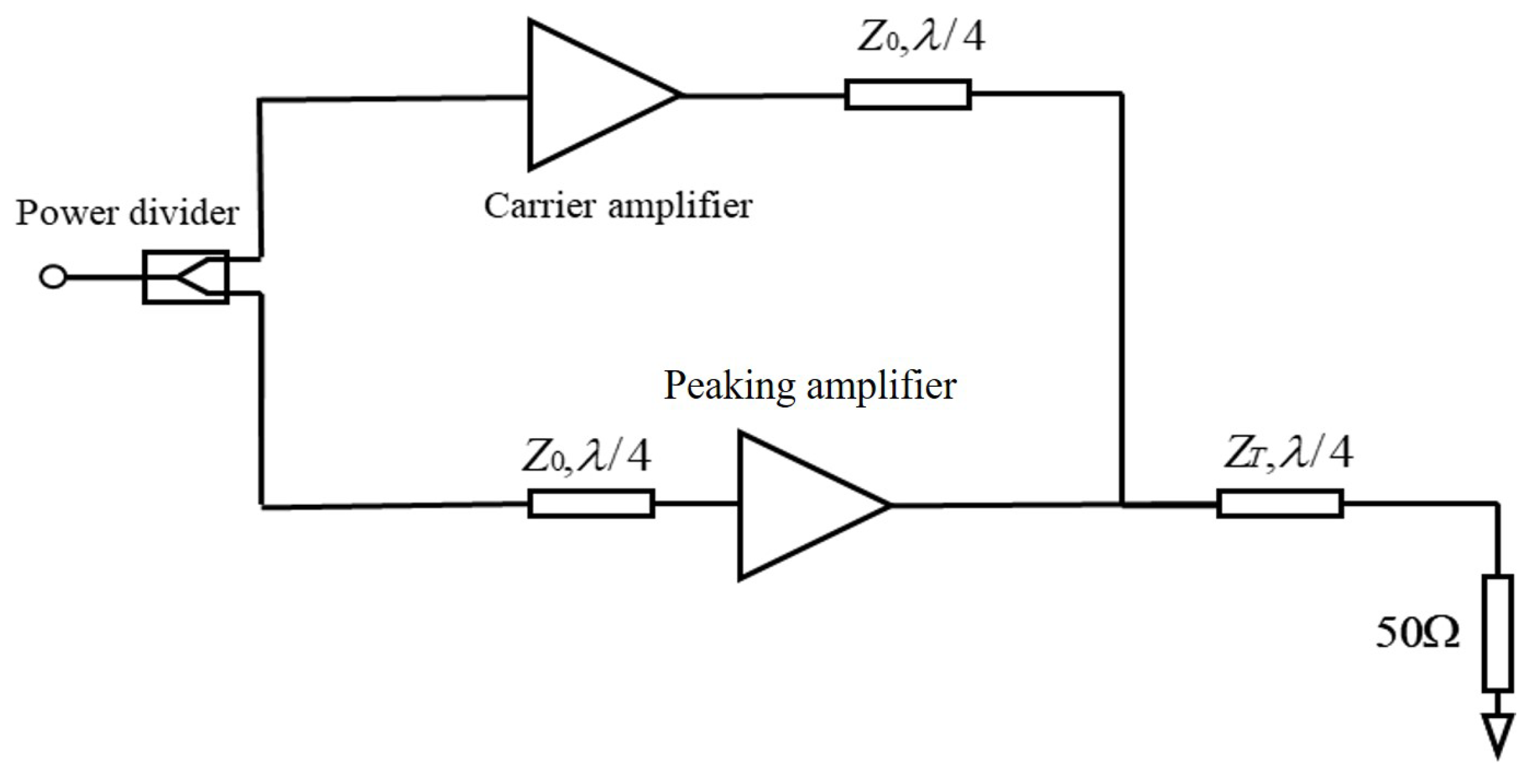
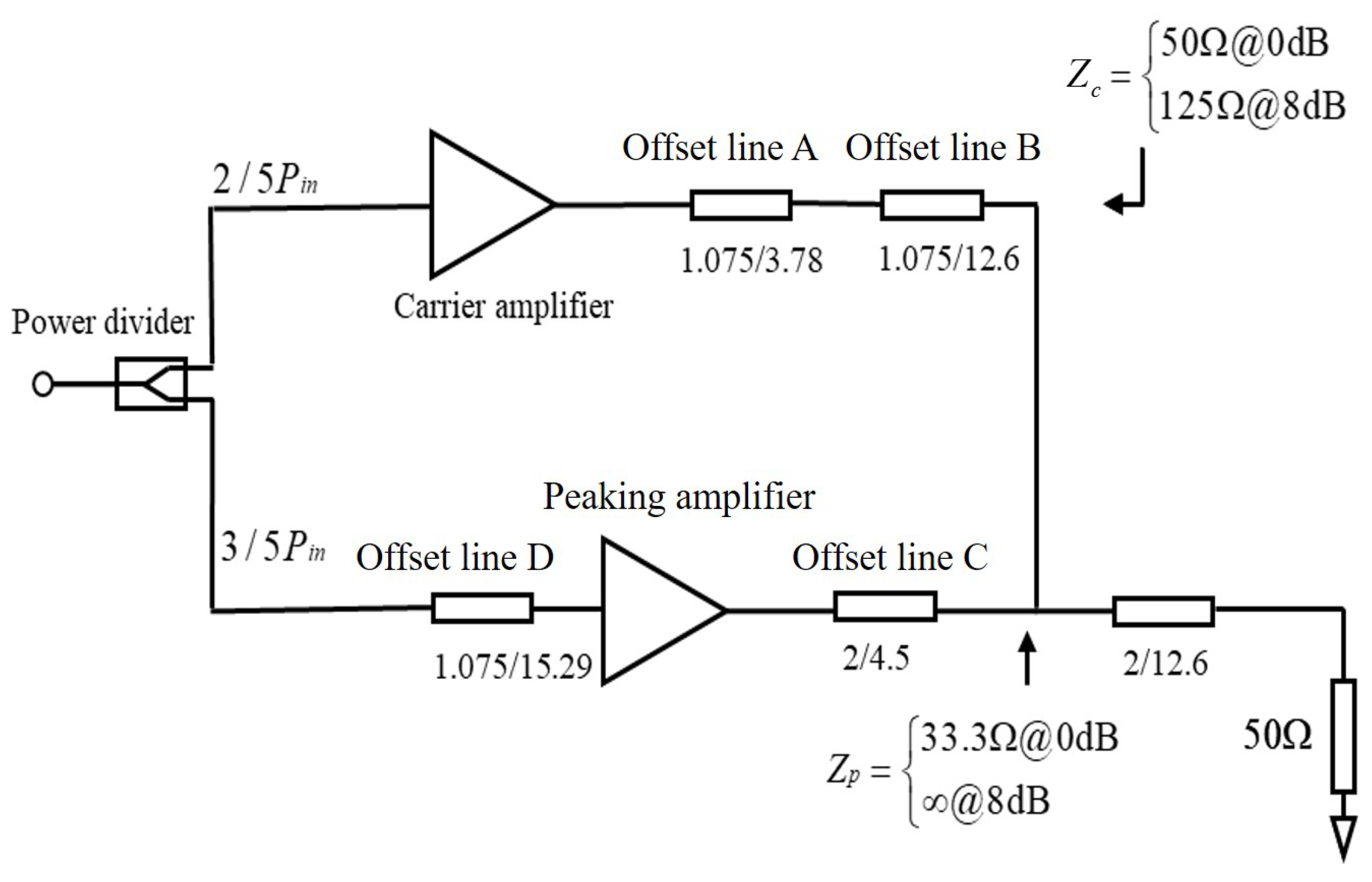
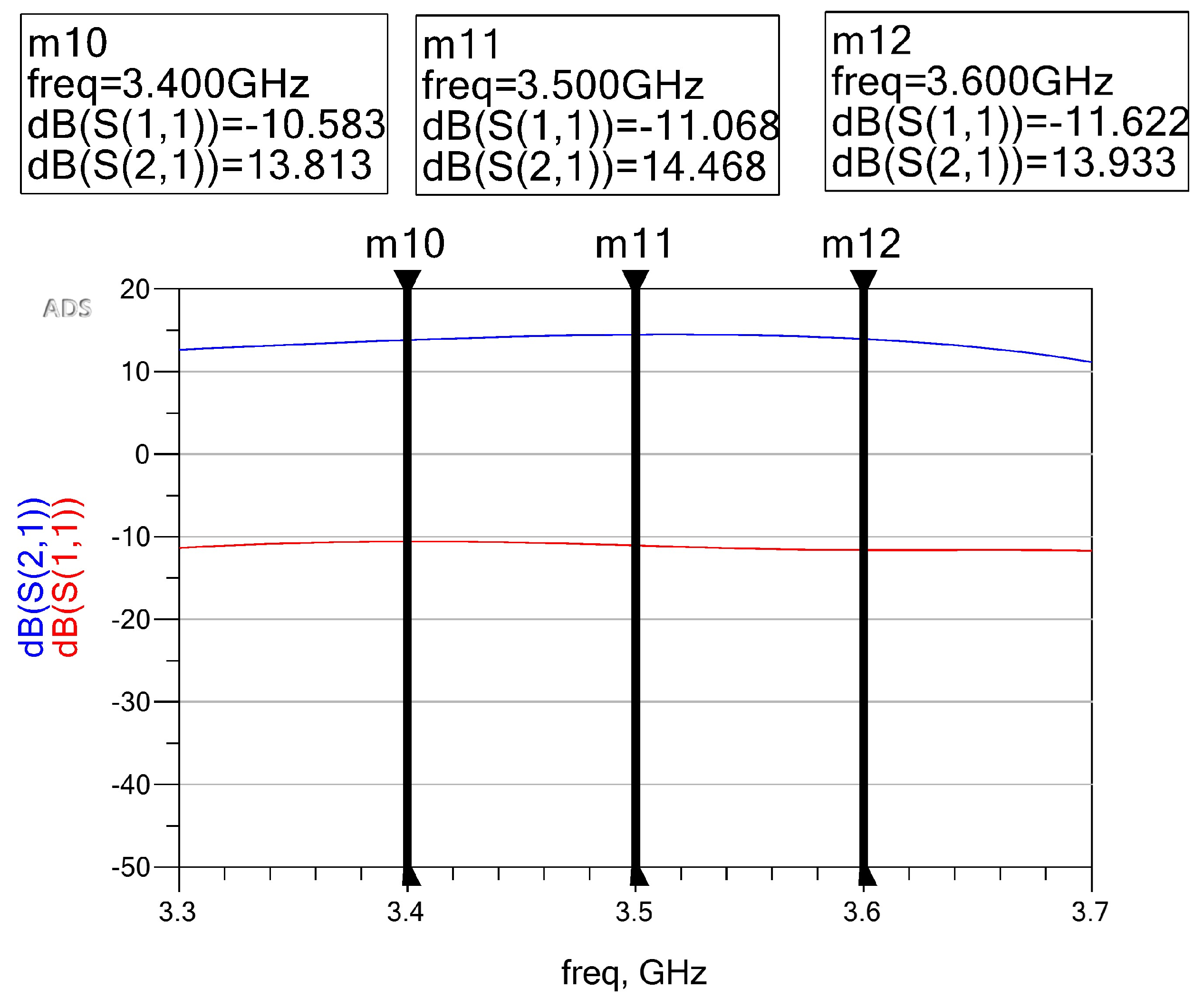


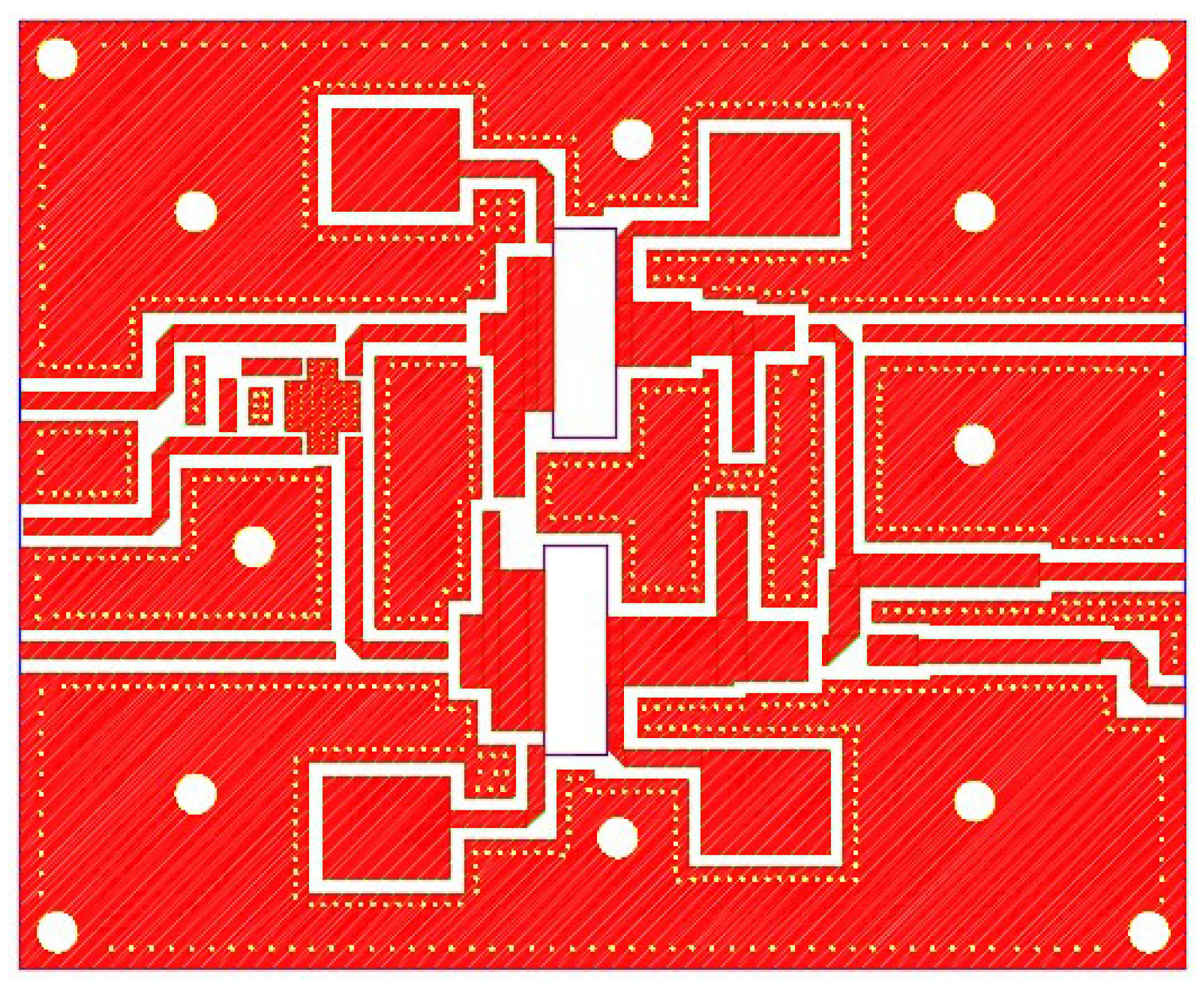
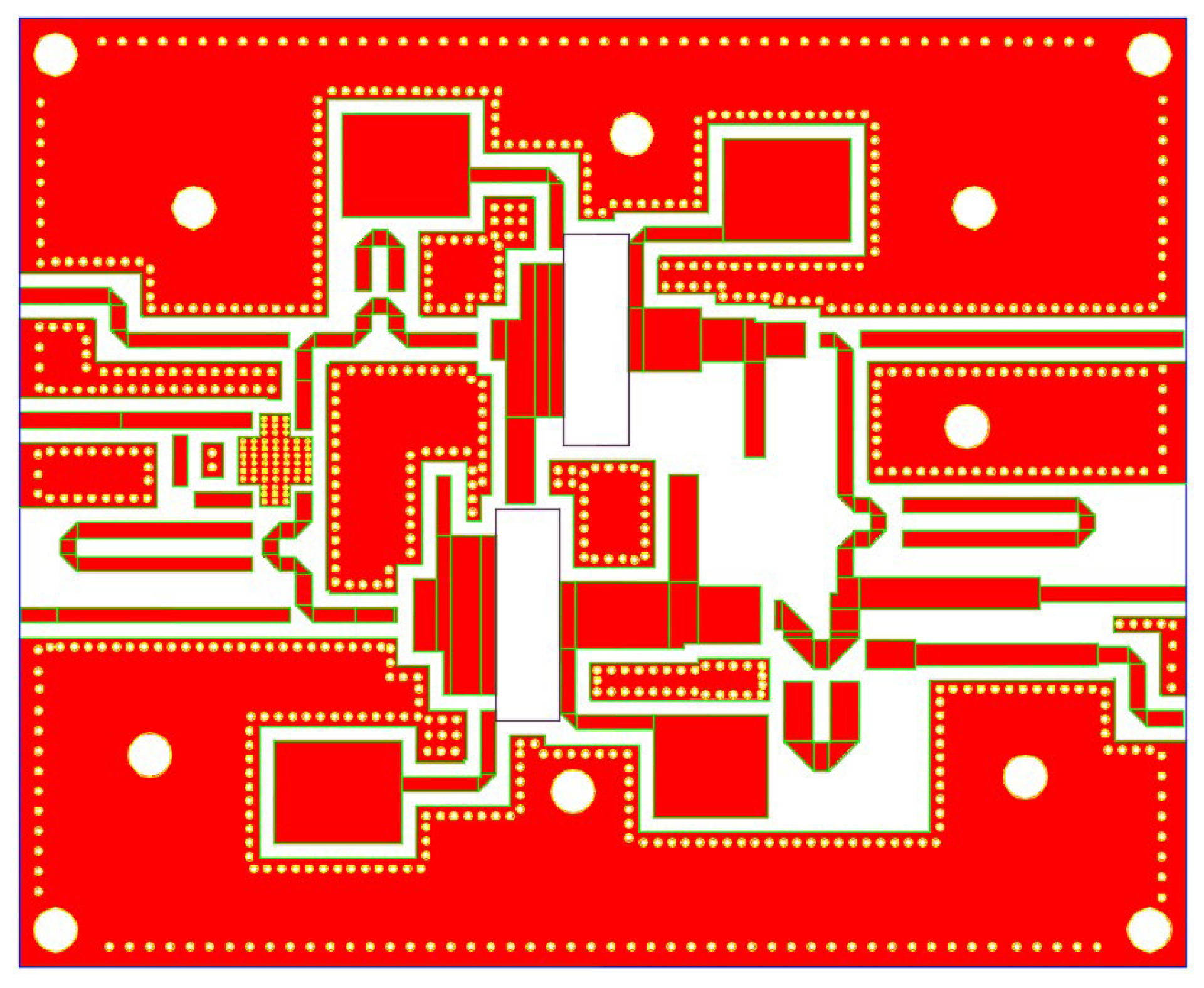


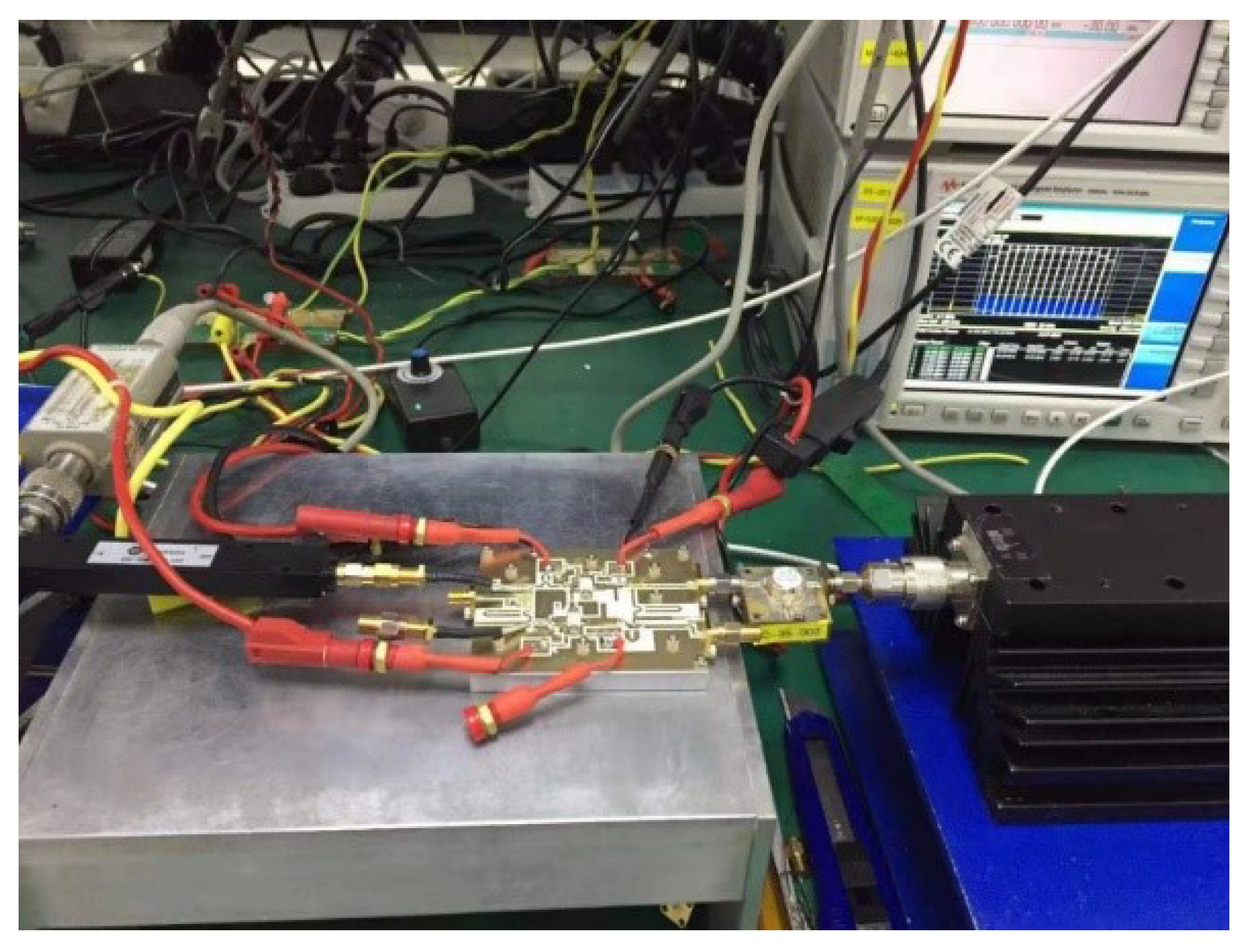

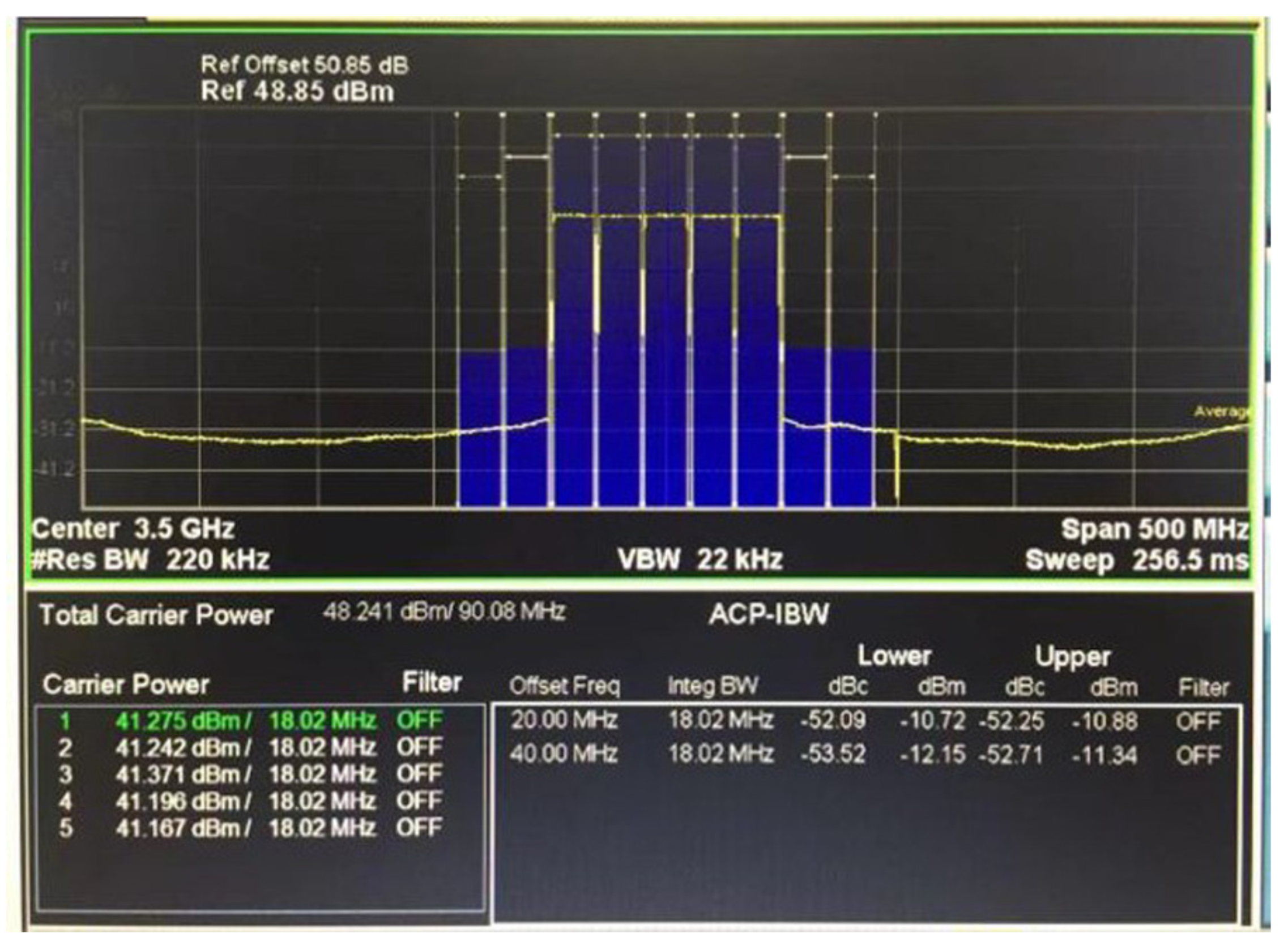
| Index | (dBm) | DE@ (%) | DE@OBO (%) | PAE@ (%) | S11 (dB) | S21 (dB) |
|---|---|---|---|---|---|---|
| Simulations | 47.86 | 74.89 | 51.29 | 67.28 | −11.07 | 14.47 |
| Tests | 47.02 | 73.50 | 47.50 | 63.72 | −10.73 | 13.83 |
Disclaimer/Publisher’s Note: The statements, opinions and data contained in all publications are solely those of the individual author(s) and contributor(s) and not of MDPI and/or the editor(s). MDPI and/or the editor(s) disclaim responsibility for any injury to people or property resulting from any ideas, methods, instructions or products referred to in the content. |
© 2025 by the authors. Licensee MDPI, Basel, Switzerland. This article is an open access article distributed under the terms and conditions of the Creative Commons Attribution (CC BY) license (https://creativecommons.org/licenses/by/4.0/).
Share and Cite
Xiao, M.; Zhang, W. A Design and Implementation of High-Efficiency Asymmetric Doherty Radio Frequency Power Amplifier for 5G Base Station Applications. Electronics 2025, 14, 1586. https://doi.org/10.3390/electronics14081586
Xiao M, Zhang W. A Design and Implementation of High-Efficiency Asymmetric Doherty Radio Frequency Power Amplifier for 5G Base Station Applications. Electronics. 2025; 14(8):1586. https://doi.org/10.3390/electronics14081586
Chicago/Turabian StyleXiao, Manlin, and Wenyu Zhang. 2025. "A Design and Implementation of High-Efficiency Asymmetric Doherty Radio Frequency Power Amplifier for 5G Base Station Applications" Electronics 14, no. 8: 1586. https://doi.org/10.3390/electronics14081586
APA StyleXiao, M., & Zhang, W. (2025). A Design and Implementation of High-Efficiency Asymmetric Doherty Radio Frequency Power Amplifier for 5G Base Station Applications. Electronics, 14(8), 1586. https://doi.org/10.3390/electronics14081586





